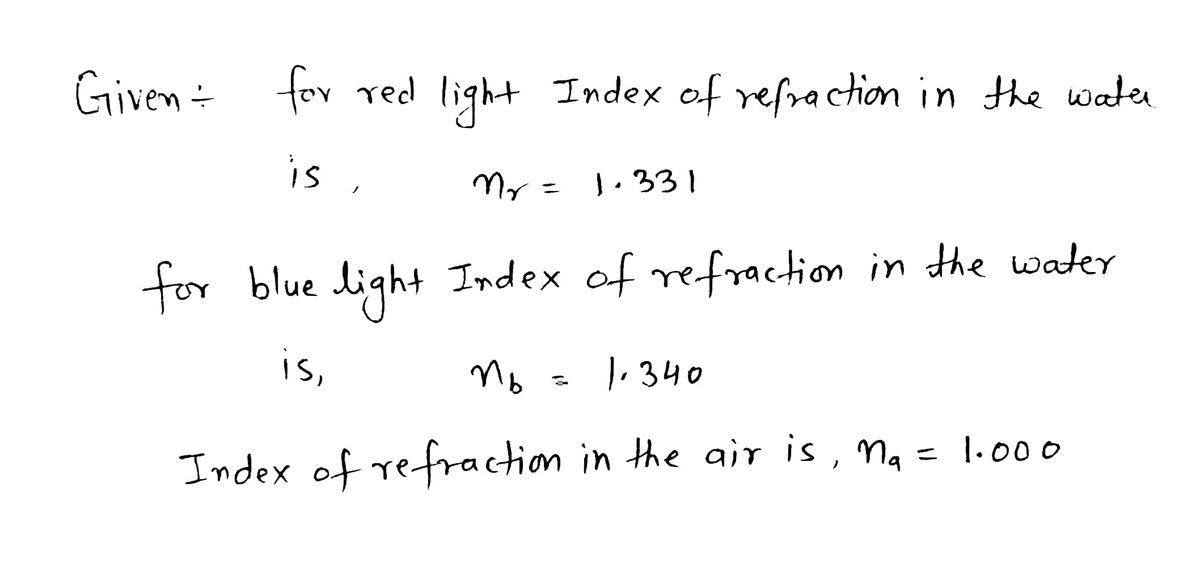RR-1 Any material can separate the different wavelengths present in white light because the index of refraction for each wavelength is slightly different. For red light in water n=1.331, for blue light in water n=1.340. a) Find the angle from the normal in water for red light that enters the water from air at an angle of 80.00⁰. b) Find the angle from the normal in water for blue light that enters the water from air at an angle of 80.00⁰. air n=1.000 water: 80.00⁰ c) Draw a figure like the one shown and show the incident ray and the refracted rays for both colors. Label the rays as "red" and "blue".
RR-1 Any material can separate the different wavelengths present in white light because the index of refraction for each wavelength is slightly different. For red light in water n=1.331, for blue light in water n=1.340. a) Find the angle from the normal in water for red light that enters the water from air at an angle of 80.00⁰. b) Find the angle from the normal in water for blue light that enters the water from air at an angle of 80.00⁰. air n=1.000 water: 80.00⁰ c) Draw a figure like the one shown and show the incident ray and the refracted rays for both colors. Label the rays as "red" and "blue".
College Physics
11th Edition
ISBN:9781305952300
Author:Raymond A. Serway, Chris Vuille
Publisher:Raymond A. Serway, Chris Vuille
Chapter1: Units, Trigonometry. And Vectors
Section: Chapter Questions
Problem 1CQ: Estimate the order of magnitude of the length, in meters, of each of the following; (a) a mouse, (b)...
Related questions
Question
100%

Transcribed Image Text:### Refraction and Wavelength Separation in Water
**RR-1**: Any material can separate the different wavelengths present in white light because the index of refraction for each wavelength is slightly different. For red light in water, the index of refraction \(n = 1.331\), and for blue light in water, \(n = 1.340\).
#### Questions:
a) **Find the angle from the normal in water for red light that enters the water from air at an angle of 80.00°.**
b) **Find the angle from the normal in water for blue light that enters the water from air at an angle of 80.00°.**
c) **Draw a figure like the one shown and show the incident ray and the refracted rays for both colors. Label the rays as "red" and "blue".**
#### Diagram Explanation:
The diagram illustrates a light ray entering from air (with a refractive index of 1.000) into water. The incident angle relative to the normal (perpendicular line) is 80.00°. The diagram is a side view indicating the change in direction of light as it moves from air into water, causing refraction.
- **Incident Ray**: The ray coming from the air at an angle of 80.00°.
- **Refracted Rays**: The diagram should show two lines within the water, bent towards the normal. One represents red light (bent less due to a lower refractive index) and the other represents blue light (bent more due to a higher refractive index). Red and blue rays should be labeled accordingly.
Expert Solution
Step 1

Step by step
Solved in 3 steps with 3 images

Knowledge Booster
Learn more about
Need a deep-dive on the concept behind this application? Look no further. Learn more about this topic, physics and related others by exploring similar questions and additional content below.Recommended textbooks for you

College Physics
Physics
ISBN:
9781305952300
Author:
Raymond A. Serway, Chris Vuille
Publisher:
Cengage Learning

University Physics (14th Edition)
Physics
ISBN:
9780133969290
Author:
Hugh D. Young, Roger A. Freedman
Publisher:
PEARSON

Introduction To Quantum Mechanics
Physics
ISBN:
9781107189638
Author:
Griffiths, David J., Schroeter, Darrell F.
Publisher:
Cambridge University Press

College Physics
Physics
ISBN:
9781305952300
Author:
Raymond A. Serway, Chris Vuille
Publisher:
Cengage Learning

University Physics (14th Edition)
Physics
ISBN:
9780133969290
Author:
Hugh D. Young, Roger A. Freedman
Publisher:
PEARSON

Introduction To Quantum Mechanics
Physics
ISBN:
9781107189638
Author:
Griffiths, David J., Schroeter, Darrell F.
Publisher:
Cambridge University Press

Physics for Scientists and Engineers
Physics
ISBN:
9781337553278
Author:
Raymond A. Serway, John W. Jewett
Publisher:
Cengage Learning

Lecture- Tutorials for Introductory Astronomy
Physics
ISBN:
9780321820464
Author:
Edward E. Prather, Tim P. Slater, Jeff P. Adams, Gina Brissenden
Publisher:
Addison-Wesley

College Physics: A Strategic Approach (4th Editio…
Physics
ISBN:
9780134609034
Author:
Randall D. Knight (Professor Emeritus), Brian Jones, Stuart Field
Publisher:
PEARSON